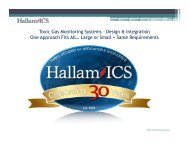SESHA 2011 Program Book - Semiconductor Safety Association
SESHA 2011 Program Book - Semiconductor Safety Association
SESHA 2011 Program Book - Semiconductor Safety Association
Create successful ePaper yourself
Turn your PDF publications into a flip-book with our unique Google optimized e-Paper software.
10:00 am-3:15 pm<br />
Risk Management<br />
Sonora B<br />
10:00 am <strong>Safety</strong> of Personnel Working Near Track<br />
for “Overhead Transportion Vehicle”<br />
Ibuka, S; Tokyo Electron Limited, Tokyo Japan<br />
Recently unmanned transportion vehicle systams<br />
running overhead (OHV:overhead transportion vehicle)<br />
are often used in almost 300mm wafer IC fabrication<br />
plants. On the other hand, height of equipment becomes<br />
higer and higher. Personnel has to work upperside of<br />
the equipment such as a furnace, wet station or coaterdeveloper.<br />
OHV is running near the personnel. How<br />
to protect the personnel not to crush into the OHV is<br />
very high concern. Recent updated SEMI S17 is one approach<br />
for vehicle safety design. At the last bSEMICON<br />
Japan, a workshop to share concerns of facts, and to discuss<br />
ideas to improve the situation among industry people.<br />
SEMI Japan and SEAJ is collaborating to plan next<br />
workshop. I would like to introduce Japanese activities<br />
for the subjects and know global audience suggestions<br />
for our approach hereafter.<br />
10:45 am Integrated e-ESH System<br />
Hsu, F-M; Hsinchu, Taiwan<br />
Integrated e-ESH System Fang-Ming Hsu Deputy<br />
Director, Risk Management and Corporate ESH Division<br />
Taiwan <strong>Semiconductor</strong> Manufacturing Company,<br />
Ltd. Chair, ESH Committee, SIA in Chinese Taipei ESH<br />
management in semiconductor industry is essential but<br />
very complex. In order to make it effective, experts<br />
may have to spend quite long time, maybe for years,<br />
for trial and error. And, after semiconductor companies<br />
with its daily management have both become mature,<br />
people often find they have lots of, or too many, ESH<br />
sub-systems in place, and some of those sub-systems are<br />
even overlapping with others. Therefore, it’s time for the<br />
companies to enhance their systems’ efficiency. A way<br />
of enhancing ESH management efficiency is computerizing<br />
and integrating all ESH management systems. Finally,<br />
an integrated e-ESH system can benefit the company<br />
not only with enhanced management effectiveness<br />
and efficiency, but also reduced cost and mitigated risks.<br />
TSMC has adopted PDCA cycles into this system and<br />
will share its experiences at this session.<br />
11:30 am Lunch on your Own<br />
1:00 pm <strong>Safety</strong> Analytics: The Future of Workforce<br />
<strong>Safety</strong> and Health<br />
Hohn, T, Duden, D; Pure<strong>Safety</strong><br />
What Is <strong>Safety</strong> Analytics? <strong>Safety</strong> analytics is an<br />
emerging science that is helping to drive improvements<br />
not only in workforce safety and health programs, but<br />
also in overall business performance. Deloitte Consulting,<br />
a leading practitioner in this field, defines safety<br />
analytics as “the science of studying the underlying<br />
causes of and contributing factors to workplace accidents.”<br />
On the surface, that may sound similar to what<br />
top workforce safety and health professionals have done<br />
all along. But what’s new — facilitated by software<br />
tools and systems like Pure<strong>Safety</strong>’s — is the amount and<br />
range of data that can be analyzed. For example, part of<br />
what distinguishes safety analytics from past practices is<br />
the use of external data (demographics, lifestyle indicators,<br />
industry financial data, etc.), as well as traditional<br />
historical and observed data. Among other benefits, this<br />
approach helps to ensure that human variables are appropriately<br />
weighted in identifying risk and taking appropriate<br />
preventive actions. Combined with the growing<br />
use of leading indicators, leveraging safety analytics<br />
gives you a more complete, and more current, picture of<br />
everything from specific work processes and locations<br />
up to the health of your safety culture in general. This,<br />
in turn, leads to a more targeted, proactive allocation of<br />
available resources and opens the path to continuous improvement<br />
in critical areas, including: • Workplace accidents<br />
and injuries • Compliance • Productivity • ROI<br />
on safety expenditures • Employee satisfaction, morale,<br />
loyalty and retention • Absenteeism • Product/material<br />
damage • Managerial efficiency and effectiveness • Corporate<br />
reputation<br />
1:45 pm Surface Contamination of Dummy Wafer<br />
and its Health Effect in <strong>Semiconductor</strong> Manufacturing<br />
Industry<br />
Choi, K; Samsung Electronics Co. LTD<br />
Dummy wafer has been effectively used to monitoring<br />
of equipment and process in semiconductor<br />
manufacturing industry. However, it has been predicted<br />
human health impacts by hazardous by-products which<br />
could be generated on the wafer surface by chemical<br />
reaction of various precursors such as toxic gases and<br />
chemicals. Although there has been much attention on<br />
the issue, it has not been studied yet. In this study, therefore,<br />
we have explored the surface contamination of the<br />
dummy wafers which have been used in semiconductor<br />
processes by quantitative and qualitative analysis meth-<br />
21




